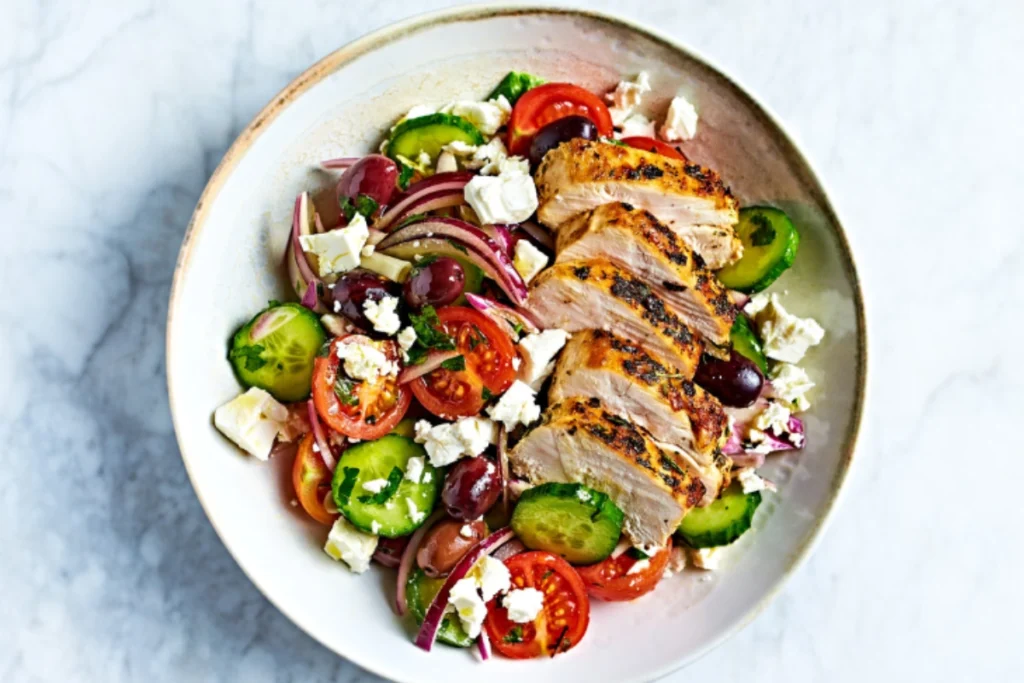Chicken salad, a culinary delight that has captivated taste buds worldwide, stands as a testament to simplicity and flavor. This dish, known for its versatility and ease of preparation, has evolved significantly since its inception, adapting to various cultural tastes and dietary preferences. At its core, chicken salad benefits typically combines chopped or shredded chicken with a creamy binder like mayonnaise or yogurt, and often includes a mix of fruits, vegetables, and nuts for added texture and flavor.
- Originating in the mid-1800s, chicken salad has become a staple in many cultures, each adding its unique twist to this classic dish.
- The basic ingredients of chicken salad, while simple, offer a canvas for culinary creativity, allowing for endless variations and flavors.
Basic Ingredients and Variations Across Cultures of Chicken Salad
In the realm of chicken salad nutritional benefits, can be a powerhouse of lean protein, essential vitamins, and minerals. The key lies in the choice of ingredients and proportions. For instance, opting for a low-fat mayonnaise or yogurt can significantly reduce calorie intake while maintaining the creamy texture that is characteristic of a classic chicken salad. For more insights into making chicken salad a healthy choice, explore Healthline’s perspective on the nutritional benefits of chicken salad.
- The inclusion of fruits, nuts, and vegetables not only enhances the flavor profile but also contributes to the overall nutritional value of the dish.
- From a simple lunch option to a sophisticated gourmet meal, chicken salad’s adaptability makes it suitable for various occasions.
Culturally, chicken salad has taken on many forms. From the American classic with grapes and walnuts to the Thai-inspired versions with chili oil and rice vinegar, the global variations of chicken salad are a testament to its universal appeal.
In summary, chicken salad’s enduring popularity is rooted in its simplicity, nutritional potential, and the endless possibilities it offers for customization and innovation.
Nutritional Benefits of Chicken Salad
The nutritional benefits of chicken salad are both varied and significant, making it a popular choice for those seeking a healthy yet satisfying meal. Central to its appeal is the lean protein provided by chicken, a crucial nutrient for muscle building and repair.
- High in Protein: Chicken is an excellent source of lean protein, essential for muscle growth and repair.
- Rich in Vitamins and Minerals: Depending on the ingredients, chicken salad can be a treasure trove of vitamins like B6 and minerals like selenium.
The versatility of chicken salad allows for the inclusion of various fruits and vegetables, which not only add flavor and texture but also boost the dish’s vitamin and mineral content. Ingredients like celery, apples, or grapes contribute essential nutrients and fiber, enhancing the overall healthfulness of the meal.
- Fiber-Rich Additions: Adding fruits and vegetables increases the fiber content, beneficial for digestive health.
- Low in Carbohydrates: Typically, chicken salad is low in carbs, making it a suitable option for low-carb diets.
The choice of binder in chicken salad, such as mayonnaise or yogurt, plays a significant role in determining the dish’s calorie and fat content. Opting for low-fat or yogurt-based dressings can make the salad a healthier option without compromising on taste.
- Healthy Fats: Using alternatives like Greek yogurt or avocado provides healthier fats and reduces calorie intake.
- Customizable for Dietary Needs: The recipe can be easily modified to suit various dietary requirements, including low-fat, low-carb, or high-protein diets.
In essence, chicken salad’s nutritional profile is highly adaptable. By choosing the right ingredients, it can be transformed into a nutrient-dense meal that supports overall health and well-being. This adaptability makes chicken salad not just a delicious choice, but a smart one for those mindful of their dietary intake.
Flavor and Texture
The allure of chicken salad largely stems from its flavor and texture, elements that make each bite both delightful and memorable. Central to its appeal is the harmonious blend of ingredients that provide a symphony of tastes and sensations.
- Creamy Binders: Mayonnaise or yogurt gives chicken salad its signature creamy texture, enhancing the overall mouthfeel.
- Crunchy Elements: Ingredients like celery, nuts, or apples add a satisfying crunch, contrasting beautifully with the creamy chicken.
The flavor profile of chicken salad is remarkably versatile, allowing for a range of culinary explorations. From the classic American version with its mild and creamy taste to more exotic variations featuring bold spices and tangy dressings, chicken salad can cater to a wide array of palates.
- Sweet and Savory Balance: The inclusion of fruits like grapes or apples introduces a sweet note, balancing the savory chicken.
- Herbs and Spices: Fresh herbs and spices can transform the flavor, adding depth and complexity.
Texture plays a crucial role in the enjoyment of chicken salad. The contrast between the tender chicken, creamy dressing, and crunchy additions creates a multi-dimensional eating experience that is both satisfying and engaging.
- Varied Textural Experience: The combination of soft, creamy, and crunchy elements ensures a diverse textural experience in every bite.
- Customizable to Preference: The texture can be easily adjusted to suit individual preferences, from chunky and rustic to smooth and refined.
In summary, the flavor and texture of chicken salad are key to its popularity. The ability to blend creamy, crunchy, sweet, and savory elements into one dish makes it a versatile and appealing choice for a wide range of tastes and occasions. Whether enjoyed as a simple lunch or a part of a sophisticated meal, chicken salad remains a beloved dish for its delightful interplay of flavors and textures.
Versatility and Convenience
The versatility and convenience of chicken salad are among its most appealing attributes, making it a favored choice for various meal settings and dietary preferences.
- Easy to Prepare: Chicken salad is known for its straightforward preparation, requiring minimal cooking skills.
- Adaptable to Various Diets: It can be customized to fit low-carb, high-protein, or vegetarian diets with appropriate substitutions.
Its ability to be served in multiple forms – as a sandwich filling, atop a bed of greens, or as a standalone dish – makes chicken salad a versatile option suitable for lunches, picnics, and even formal gatherings.
- Suitable for Various Meal Types: Perfect for a quick lunch, a picnic treat, or as part of a formal meal.
- Great for Meal Prep: Chicken salad can be prepared in advance, making it a convenient option for meal planning and busy schedules.
In essence, the versatility and convenience of chicken salad lie in its simplicity and adaptability, catering to a wide range of tastes and occasions with ease. This makes it not just a delicious choice, but also a practical one for everyday meals and special events alike.
Health Considerations
When considering the health aspects of chicken salad, it’s important to balance its nutritional benefits with potential concerns. This balance is key to enjoying chicken salad as part of a healthy diet.
- Calorie Content: Be mindful of the calorie content, especially from mayonnaise or creamy dressings.
- Saturated Fats: Some versions may be high in saturated fats, depending on the type of binder used.
Choosing healthier alternatives for traditional ingredients can significantly enhance the nutritional profile of chicken salad. For instance, opting for low-fat mayonnaise or yogurt can reduce calorie and fat intake without compromising taste.
- Healthier Alternatives: Use Greek yogurt or avocado instead of mayonnaise for a healthier version.
- Portion Control: Be aware of serving sizes to manage calorie intake effectively.
Food safety is another crucial aspect, especially since chicken salad often contains ingredients like mayonnaise that can spoil easily. Proper storage and handling are essential to prevent foodborne illnesses.
- Food Safety: Store chicken salad in the refrigerator and consume within a safe time frame.
- Risk of Foodborne Illness: Be cautious of ingredients that can spoil quickly, especially in warmer temperatures.
In summary, while chicken salad can be a nutritious and satisfying meal option, it’s important to consider the health implications of its ingredients and preparation. By making mindful choices and practicing safe food handling, chicken salad can be enjoyed as a healthy part of a balanced diet.
Culinary Creativity
The culinary creativity inherent in chicken salad is a testament to its enduring popularity. This dish serves as a canvas for a wide array of flavors and textures, allowing for endless innovation in the kitchen.
- Innovative Recipes: Experiment with different cuisines to create unique chicken salad variations.
- Diverse Ingredients: Incorporate a variety of fruits, vegetables, nuts, and dressings for new flavor profiles.
From the classic American chicken salad to exotic, globally-inspired versions, the possibilities are virtually limitless. This versatility invites both amateur cooks and professional chefs to explore and experiment.
- Fusion of Cuisines: Blend elements from different culinary traditions for a unique twist.
- Healthier Versions: Create lighter versions using ingredients like Greek yogurt or leaner cuts of chicken.
The key to culinary creativity with chicken salad lies in balancing flavors and textures. Combining crunchy elements with creamy dressings, or mixing sweet fruits with savory chicken, can result in delightful contrasts that tantalize the taste buds.
- Balancing Flavors and Textures: Aim for a harmonious blend of sweet, savory, crunchy, and creamy elements.
- Ingredient Substitutions: Adapt the recipe to dietary needs or personal preferences with suitable substitutes.
In summary, chicken salad’s culinary creativity is limited only by the imagination. Whether sticking to traditional recipes or venturing into new culinary territories, chicken salad remains a versatile and beloved dish, capable of satisfying a wide range of tastes and dietary preferences.
FAQs
What are the best types of chicken to use for chicken salad?
Ideal Chicken Types: Opt for cooked, boneless chicken breasts or rotisserie chicken for convenience and flavor.
How can I make chicken salad healthier?
Healthier Alternatives: Use Greek yogurt or low-fat mayonnaise, and add more fruits and vegetables for added nutrients.
What are some creative ways to serve chicken salad?
Serving Suggestions: Serve on whole-grain bread, atop a bed of greens, or stuffed in bell peppers for variety.
Can chicken salad be made in advance, and how long will it last in the fridge?
Storage and Shelf Life: Chicken salad can be made ahead and typically lasts 3-4 days in the refrigerator.
Are there vegetarian or vegan alternatives to traditional chicken salad?
Plant-Based Options: Substitute chicken with chickpeas, tofu, or tempeh for a vegetarian or vegan version.
How can I ensure my chicken salad is safe to eat, especially during summer picnics?
Food Safety Tips: Keep chicken salad chilled and avoid leaving it out for more than 2 hours, especially in hot weather.
What are some low-carb options for chicken salad?
Low-Carb Variations: Serve with lettuce wraps or mixed greens instead of bread for a low-carb option.
Can chicken salad be frozen for later use?
Freezing Tips: It’s not recommended to freeze chicken salad, especially if it contains mayonnaise or dairy-based dressings.
What are some common allergens in chicken salad?
Allergen Awareness: Be aware of nuts, eggs (in mayonnaise), and dairy (in certain dressings) as potential allergens.
How can I add international flavors to my chicken salad?
Global Flavors: Experiment with spices, herbs, and dressings from various cuisines to add an international twist.
Conclusion
In conclusion, chicken salad stands out as a versatile and beloved dish, cherished for its delightful blend of flavors, textures, and nutritional benefits. Its adaptability allows it to be customized to fit a wide array of dietary preferences, making it a suitable choice for various meal occasions, from quick lunches to elegant gatherings. By considering healthier ingredient options and being mindful of food safety, chicken salad can be enjoyed as part of a balanced and nutritious diet. The dish’s simplicity invites culinary creativity, encouraging both home cooks and professional chefs to experiment with different ingredients and flavors. Whether you prefer the classic version or a more innovative take, chicken salad remains a timeless and satisfying meal option.



